wheel alignment NISSAN PULSAR 1987 User Guide
[x] Cancel search | Manufacturer: NISSAN, Model Year: 1987, Model line: PULSAR, Model: NISSAN PULSAR 1987Pages: 238, PDF Size: 28.91 MB
Page 163 of 238
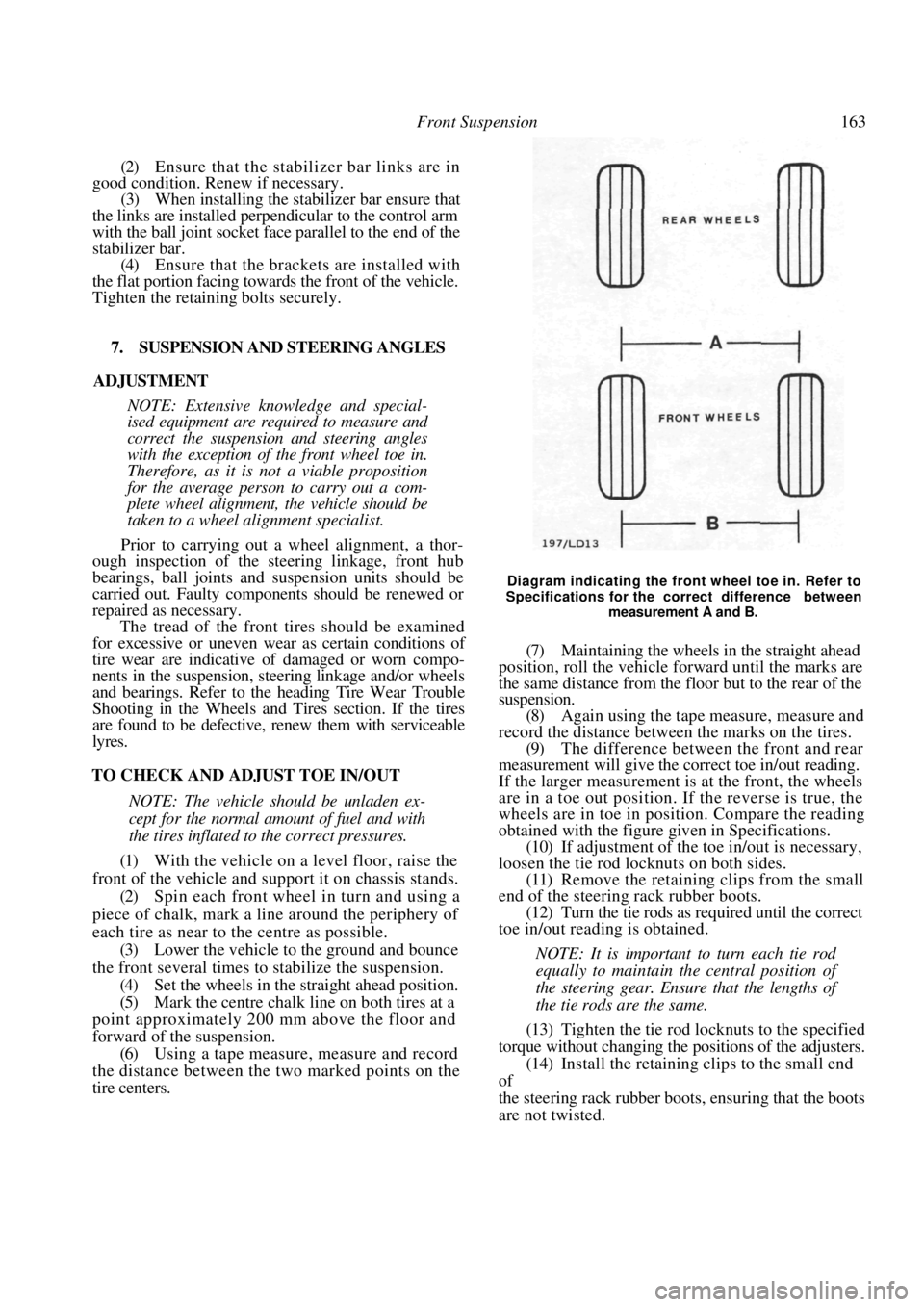
Front Suspension 163
(2) Ensure that the stabilizer bar links are in
good condition. Renew if necessary.
(3) When installing the stabilizer bar ensure that
the links are installed perpendicular to the control arm
with the ball joint socket face parallel to the end of the
stabilizer bar. (4) Ensure that the brackets are installed with
the flat portion facing towards the front of the vehicle.
Tighten the retaining bolts securely.
7. SUSPENSION AND STEERING ANGLES
ADJUSTMENT
NOTE: Extensive knowledge and special-
ised equipment are required to measure and
correct the suspension and steering angles
with the exception of the front wheel toe in.
Therefore, as it is not a viable proposition
for the average person to carry out a com-
plete wheel alignment, the vehicle should be
taken to a wheel alignment specialist.
Prior to carrying out a wheel alignment, a thor-
ough inspection of the steering linkage, front hub
bearings, ball joints and suspension units should be
carried out. Faulty components should be renewed or
repaired as necessary.
The tread of the front ti res should be examined
for excessive or uneven wear as certain conditions of
tire wear are indicative of damaged or worn compo-
nents in the suspension, stee ring linkage and/or wheels
and bearings. Refer to the heading Tire Wear Trouble
Shooting in the Wheels and Tires section. If the tires
are found to be defective, renew them with serviceable
lyres.
TO CHECK AND ADJUST TOE IN/OUT
NOTE: The vehicle s hould be unladen ex-
cept for the normal amount of fuel and with
the tires inflated to the correct pressures.
(1) With the vehicle on a level floor, raise the
front of the vehicle and s upport it on chassis stands.
(2) Spin each front wheel in turn and using a
piece of chalk, mark a line around the periphery of
each tire as near to the centre as possible. (3) Lower the vehicle to the ground and bounce
the front several times to stabilize the suspension. (4) Set the wheels in the straight ahead position.
(5) Mark the centre chalk line on both tires at a
point approximately 200 mm above the floor and
forward of the suspension. (6) Using a tape measure, measure and record
the distance between the two marked points on the
tire centers.
Diagram indicating the front wheel toe in. Refer to
Specifications for the correct difference between
measurement A and B.
(7) Maintaining the wheels in the straight ahead
position, roll the vehicle forward until the marks are
the same distance from the floor but to the rear of the
suspension. (8) Again using the tape measure, measure and
record the distance between the marks on the tires.
(9) The difference between the front and rear
measurement will give the correct toe in/out reading.
If the larger measurement is at the front, the wheels
are in a toe out position. If the reverse is true, the
wheels are in toe in position. Compare the reading
obtained with the figure given in Specifications.
(10) If adjustment of the to e in/out is necessary,
loosen the tie rod locknuts on both sides. (11) Remove the retaining clips from the small
end of the steering rack rubber boots. (12) Turn the tie rods as required until the correct
toe in/out reading is obtained.
NOTE: It is important to turn each tie rod
equally to maintain the central position of
the steering gear. Ensure that the lengths of
the tie rods are the same.
(13) Tighten the tie rod locknuts to the specified
torque without changing the positions of the adjusters.
(14) Install the retaining clips to the small end
of
the steering rack rubber boots, ensuring that the boots
are not twisted.
Page 164 of 238
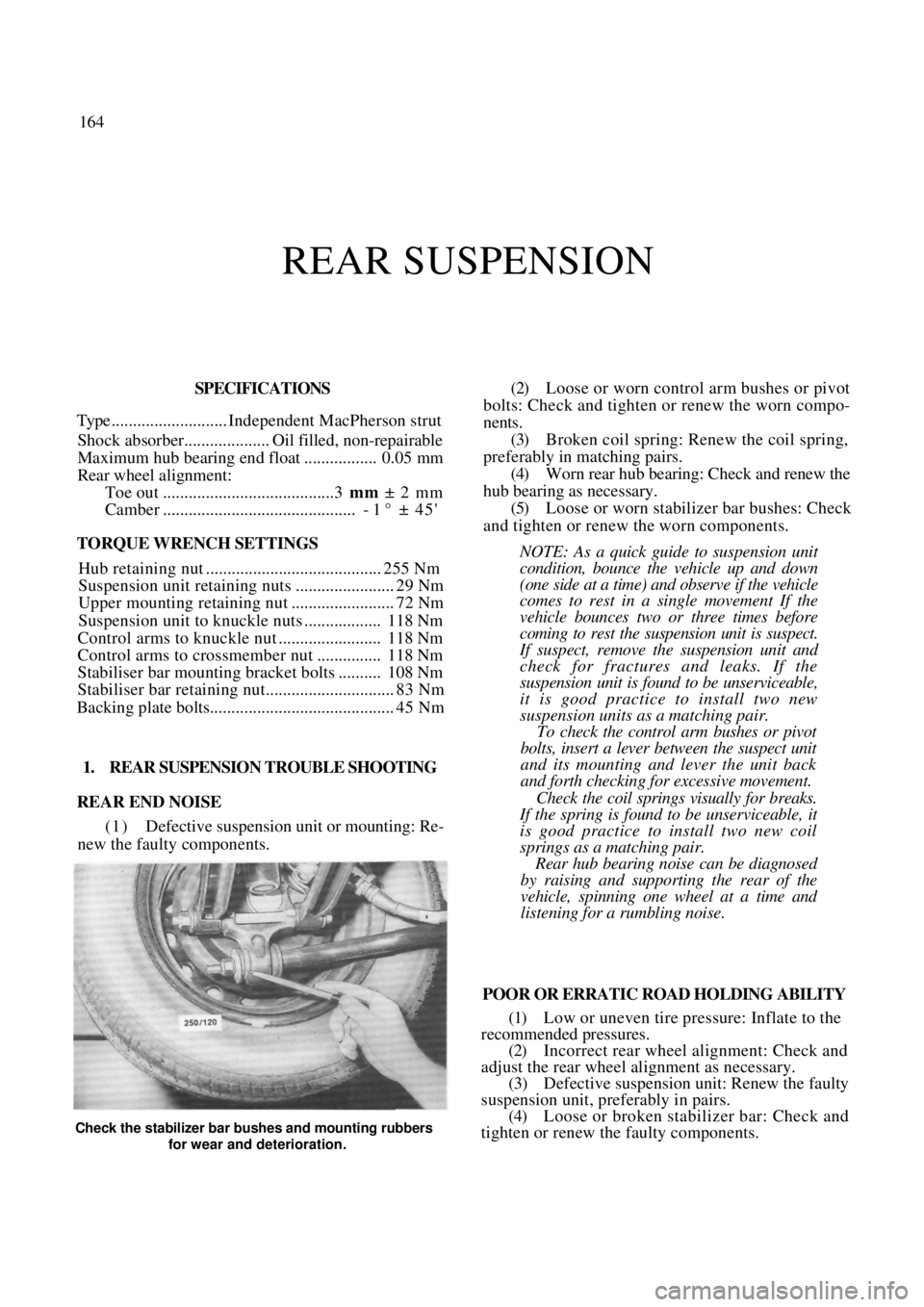
164
REAR SUSPENSION
SPECIFICATIONS
Type........................... Independent MacPherson strut
Shock absorber.................... Oil filled, non-repairable
Maximum hub bearing end float ................. 0.05 mm
Rear wheel alignment:
Toe out ........................................3 mm ± 2 mm
Camber ............................................. - 1 ° ± 4 5 '
TORQUE WRENCH SETTINGS
Hub retaining nut ......................................... 255 Nm
Suspension unit retaining nuts ....................... 29 Nm
Upper mounting retaining nut ........................ 72 Nm
Suspension unit to knuckle nuts .................. 118 Nm
Control arms to knuckle nut ........................ 118 Nm
Control arms to crossmember nut ............... 118 Nm
Stabiliser bar mounting bracket bolts .......... 108 Nm
Stabiliser bar retaining nut.............................. 83 Nm
Backing plate bolts........................................... 45 Nm
1. REAR SUSPENSION TROUBLE SHOOTING
REAR END NOISE
( 1 ) Defective suspension unit or mounting: Re-
new the faulty components.
(2) Loose or worn control arm bushes or pivot
bolts: Check and tighten or renew the worn compo-
nents. (3) Broken coil spring: Renew the coil spring,
preferably in matching pairs. (4) Worn rear hub bearing: Check and renew the
hub bearing as necessary. (5) Loose or worn stabilizer bar bushes: Check
and tighten or renew the worn components.
NOTE: As a quick guide to suspension unit
condition, bounce the vehicle up and down
(one side at a time) and observe if the vehicle
comes to rest in a single movement If the
vehicle bounces two or three times before
coming to rest the susp ension unit is suspect.
If suspect, remove the suspension unit and
check for fractures and leaks. If the
suspension unit is found to be unserviceable,
it is good practice to install two new
suspension units as a matching pair.
To check the control arm bushes or pivot
bolts, insert a lever between the suspect unit
and its mounting and lever the unit back
and forth checking for excessive movement.
Check the coil springs visually for breaks.
If the spring is found to be unserviceable, it
is good practice to install two new coil
springs as a matching pair.
Rear hub bearing noise can be diagnosed
by raising and supporting the rear of the
vehicle, spinning one wheel at a time and
listening for a rumbling noise.
POOR OR ERRATIC ROAD HOLDING ABILITY
(1) Low or uneven tire pressure: Inflate to the
recommended pressures.
(2) Incorrect rear wheel alignment: Check and
adjust the rear wheel alignment as necessary.
(3) Defective suspension unit: Renew the faulty
suspension unit, preferably in pairs. (4) Loose or broken stabilizer bar: Check and
tighten or renew the faulty components.
Check the stabilizer bar bushes and mounting rubbers
for wear and deterioration.
Page 165 of 238
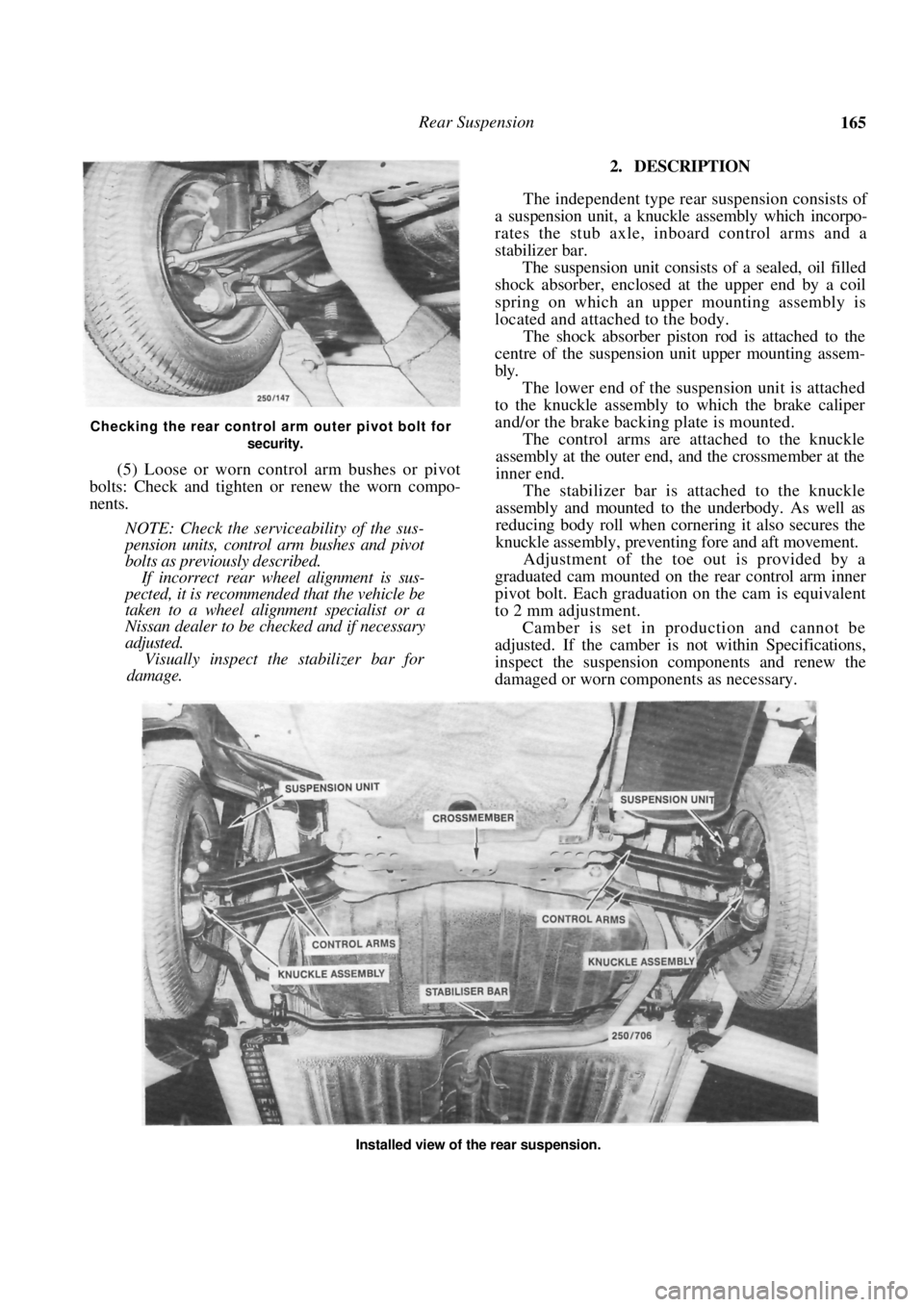
Rear Suspension 165
Checking the rear control arm outer pivot bolt for security.
(5) Loose or worn control arm bushes or pivot
bolts: Check and tighten or renew the worn compo-
nents.
NOTE: Check the service ability of the sus-
pension units, control arm bushes and pivot
bolts as previously described.
If incorrect rear wheel alignment is sus-
pected, it is recommended that the vehicle be
taken to a wheel alignment specialist or a
Nissan dealer to be checked and if necessary
adjusted.
Visually inspect the stabilizer bar for
damage.
2. DESCRIPTION
The independent type rear suspension consists of
a suspension unit, a knuckle assembly which incorpo-
rates the stub axle, inboard control arms and a
stabilizer bar.
The suspension unit consists of a sealed, oil filled
shock absorber, enclosed at the upper end by a coil
spring on which an upper mounting assembly is
located and attached to the body.
The shock absorber piston rod is attached to the
centre of the suspension unit upper mounting assem-
bly.
The lower end of the suspension unit is attached
to the knuckle assembly to which the brake caliper
and/or the brake backing plate is mounted.
The control arms are attached to the knuckle
assembly at the outer end, and the crossmember at the
inner end.
The stabilizer bar is attached to the knuckle
assembly and mounted to the underbody. As well as
reducing body roll when cornering it also secures the
knuckle assembly, preventing fore and aft movement.
Adjustment of the toe out is provided by a
graduated cam mounted on the rear control arm inner
pivot bolt. Each graduation on the cam is equivalent
to 2 mm adjustment.
Camber is set in production and cannot be
adjusted. If the camber is not within Specifications,
inspect the suspension components and renew the
damaged or worn components as necessary.
Installed view of the rear suspension.
Page 169 of 238
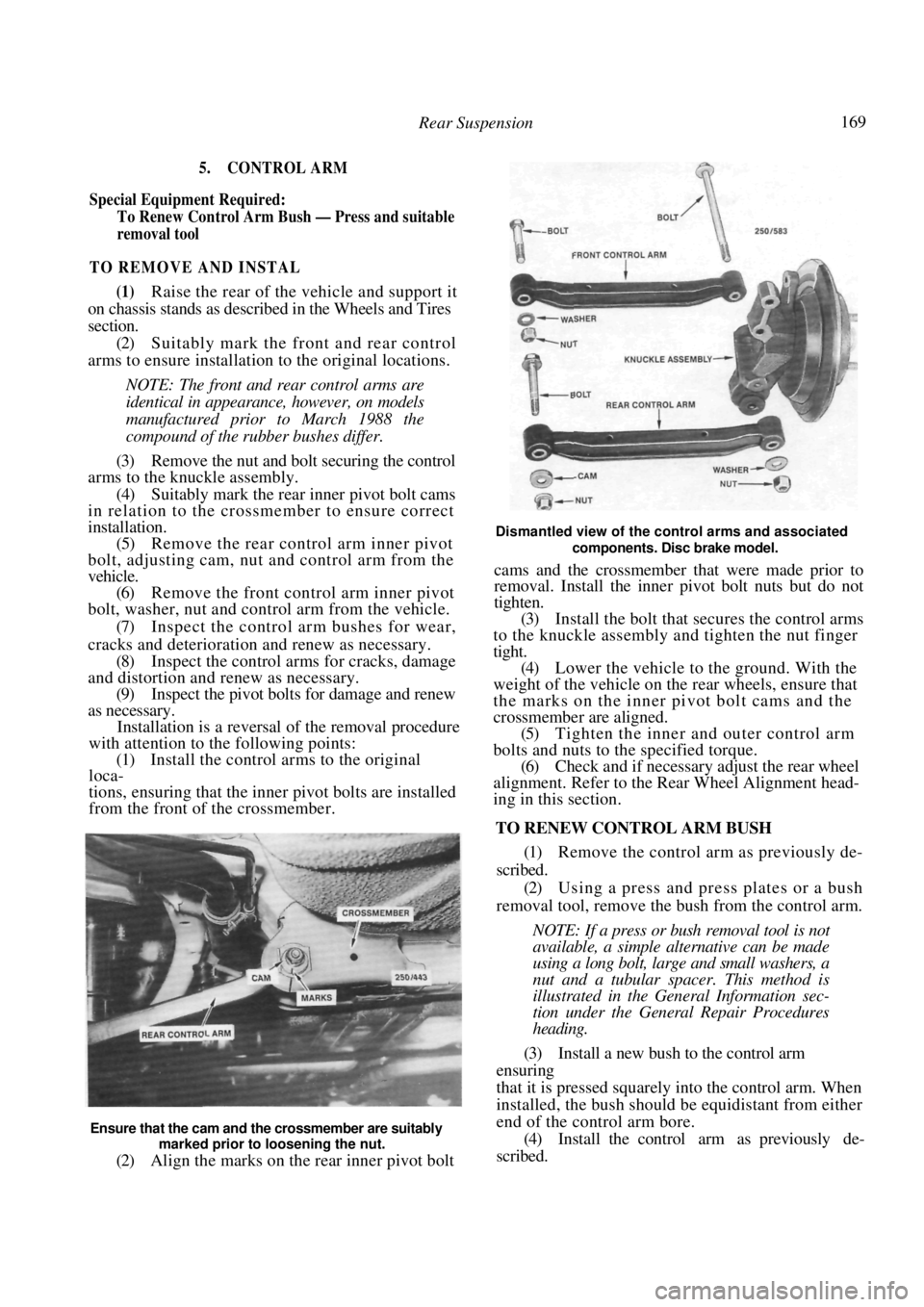
Rear Suspension 169
5. CONTROL ARM
Special Equipment Required:
To Renew Control Arm Bush — Press and suitable
removal tool
TO REMOVE AND INSTAL
(1) Raise the rear of the vehicle and support it
on chassis stands as describe d in the Wheels and Tires
section.
(2) Suitably mark the front and rear control
arms to ensure installation to the original locations.
NOTE: The front and rear control arms are
identical in appearance, however, on models
manufactured prior to March 1988 the
compound of the rubber bushes differ.
(3) Remove the nut and bolt securing the control
arms to the knuckle assembly.
(4) Suitably mark the rear inner pivot bolt cams
in relation to the crossmember to ensure correct
installation.
(5) Remove the rear control arm inner pivot
bolt, adjusting cam, nut and control arm from the
vehicle. (6) Remove the front control arm inner pivot
bolt, washer, nut and control arm from the vehicle.
(7) Inspect the control arm bushes for wear,
cracks and deterioration and renew as necessary. (8) Inspect the control arms for cracks, damage
and distortion and renew as necessary.
(9) Inspect the pivot bolts for damage and renew
as necessary. Installation is a reversal of the removal procedure
with attention to the following points:
(1) Install the control arms to the original
loca-
tions, ensuring that the inner pivot bolts are installed
from the front of the crossmember.
(2) Align the marks on the rear inner pivot bolt
Dismantled view of the control arms and associated
components. Disc brake model.
cams and the crossmember that were made prior to
removal. Install the inner pivot bolt nuts but do not
tighten.
(3) Install the bolt that secures the control arms
to the knuckle assembly and tighten the nut finger
tight. (4) Lower the vehicle to the ground. With the
weight of the vehicle on th e rear wheels, ensure that
the marks on the inner pivot bolt cams and the
crossmember are aligned. (5) Tighten the inner and outer control arm
bolts and nuts to the specified torque. (6) Check and if necessary adjust the rear wheel
alignment. Refer to the Re ar Wheel Alignment head-
ing in this section.
TO RENEW CONTROL ARM BUSH
(1) Remove the control arm as previously de-
scribed. (2) Using a press and press plates or a bush
removal tool, remove the bush from the control arm.
NOTE: If a press or bush removal tool is not
available, a simple alternative can be made
using a long bolt, large and small washers, a
nut and a tubular spacer. This method is
illustrated in the General Information sec-
tion under the General Repair Procedures
heading.
(3) Install a new bush to the control arm
ensuring
that it is pressed squarely into the control arm. When
installed, the bush should be equidistant from either
end of the control arm bore. (4) Install the control arm as previously de-
scribed.
Ensure that the cam and the crossmember are suitably
marked prior to loosening the nut.
Page 170 of 238
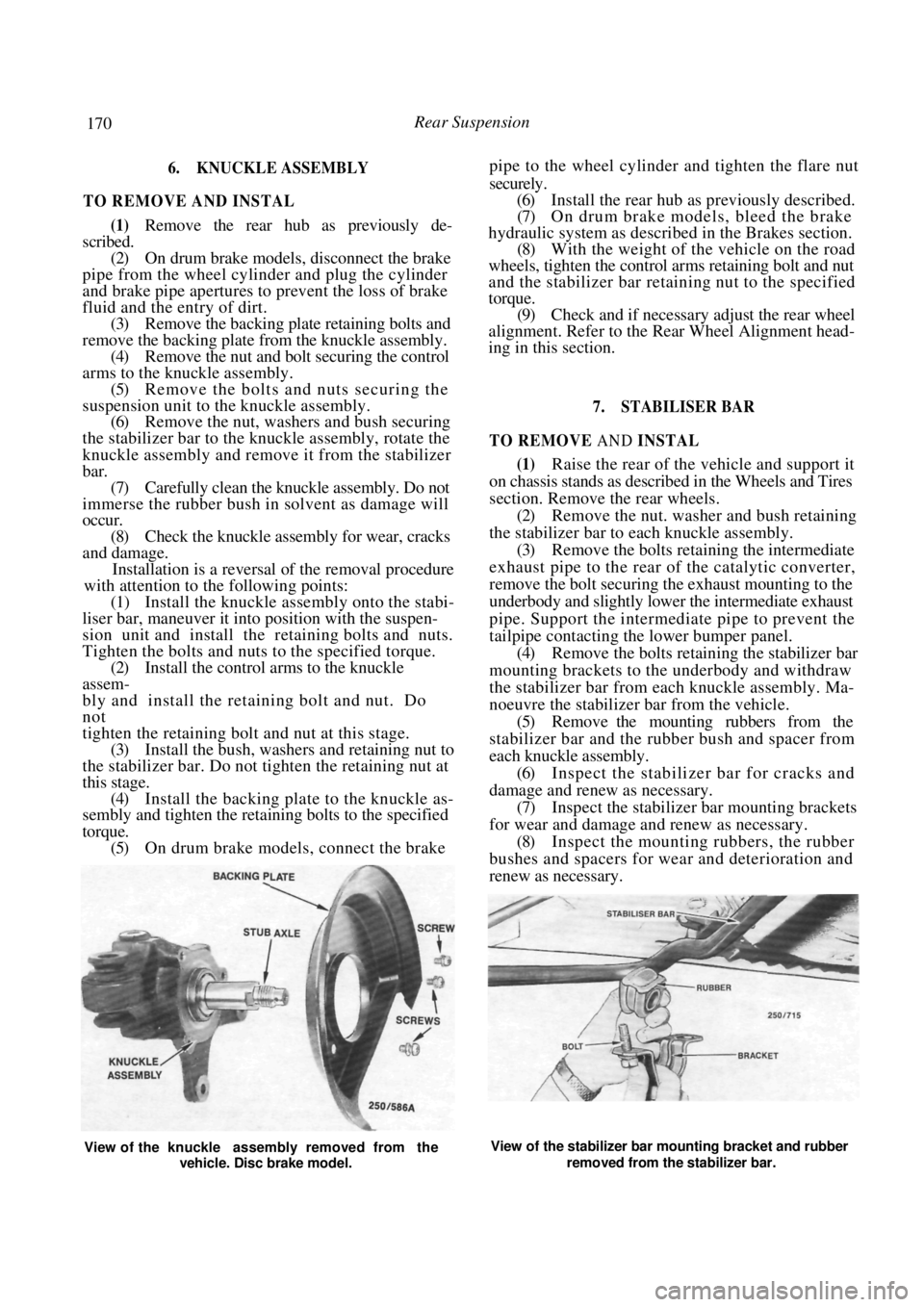
170 Rear Suspension
6. KNUCKLE ASSEMBLY
TO REMOVE AND INSTAL
(1) Remove the rear hub as previously de-
scribed.
(2) On drum brake models, disconnect the brake
pipe from the wheel cylinder and plug the cylinder
and brake pipe apertures to prevent the loss of brake
fluid and the entry of dirt. (3) Remove the backing plate retaining bolts and
remove the backing plate from the knuckle assembly. (4) Remove the nut and bolt securing the control
arms to the knuckle assembly. (5) Remove the bolts and nuts securing the
suspension unit to the knuckle assembly. (6) Remove the nut, washers and bush securing
the stabilizer bar to the knuckle assembly, rotate the
knuckle assembly and remove it from the stabilizer
bar. (7) Carefully clean the knuckle assembly. Do not
immerse the rubber bush in solvent as damage will
occur.
(8) Check the knuckle assembly for wear, cracks
and damage. Installation is a reversal of the removal procedure
with attention to the following points:
(1) Install the knuckle assembly onto the stabi-
liser bar, maneuver it into position with the suspen-
sion unit and install the retaining bolts and nuts.
Tighten the bolts and nuts to the specified torque.
(2) Install the control arms to the knuckle
assem-
bly and install the retaining bolt and nut. Do
not
tighten the retaining bolt and nut at this stage. (3) Install the bush, washers and retaining nut to
the stabilizer bar. Do not tighten the retaining nut at
this stage. (4) Install the backing plate to the knuckle as-
sembly and tighten the retaining bolts to the specified
torque.
(5) On drum brake models, connect the brake
pipe to the wheel cylinder and tighten the flare nut
securely.
(6) Install the rear hub as previously described.
(7) On drum brake models, bleed the brake
hydraulic system as described in the Brakes section.
(8) With the weight of the vehicle on the road
wheels, tighten the control arms retaining bolt and nut
and the stabilizer bar retaining nut to the specified
torque. (9) Check and if necessary adjust the rear wheel
alignment. Refer to the Re ar Wheel Alignment head-
ing in this section.
7. STABILISER BAR
TO REMOVE AND INSTAL
(1) Raise the rear of the vehicle and support it
on chassis stands as describe d in the Wheels and Tires
section. Remove the rear wheels.
(2) Remove the nut. washer and bush retaining
the stabilizer bar to each knuckle assembly. (3) Remove the bolts retain ing the intermediate
exhaust pipe to the rear of the catalytic converter,
remove the bolt securing the exhaust mounting to the
underbody and slightly lower the intermediate exhaust
pipe. Support the intermediate pipe to prevent the
tailpipe contacting the lower bumper panel. (4) Remove the bolts retaining the stabilizer bar
mounting brackets to the underbody and withdraw
the stabilizer ba r from each knuckle assembly. Ma-
noeuvre the stabilizer bar from the vehicle.
(5) Remove the mounting rubbers from the
stabilizer bar and the rubber bush and spacer from
each knuckle assembly. (6) Inspect the stabilizer bar for cracks and
damage and renew as necessary. (7) Inspect the stabilizer bar mounting brackets
for wear and damage and renew as necessary. (8) Inspect the mounting rubbers, the rubber
bushes and spacers for wear and deterioration and
renew as necessary.
View of the knuckle assembly removed from the
vehicle. Disc brake model. View of the stabilizer bar mounting bracket and rubber
removed from the stabilizer bar.
Page 171 of 238
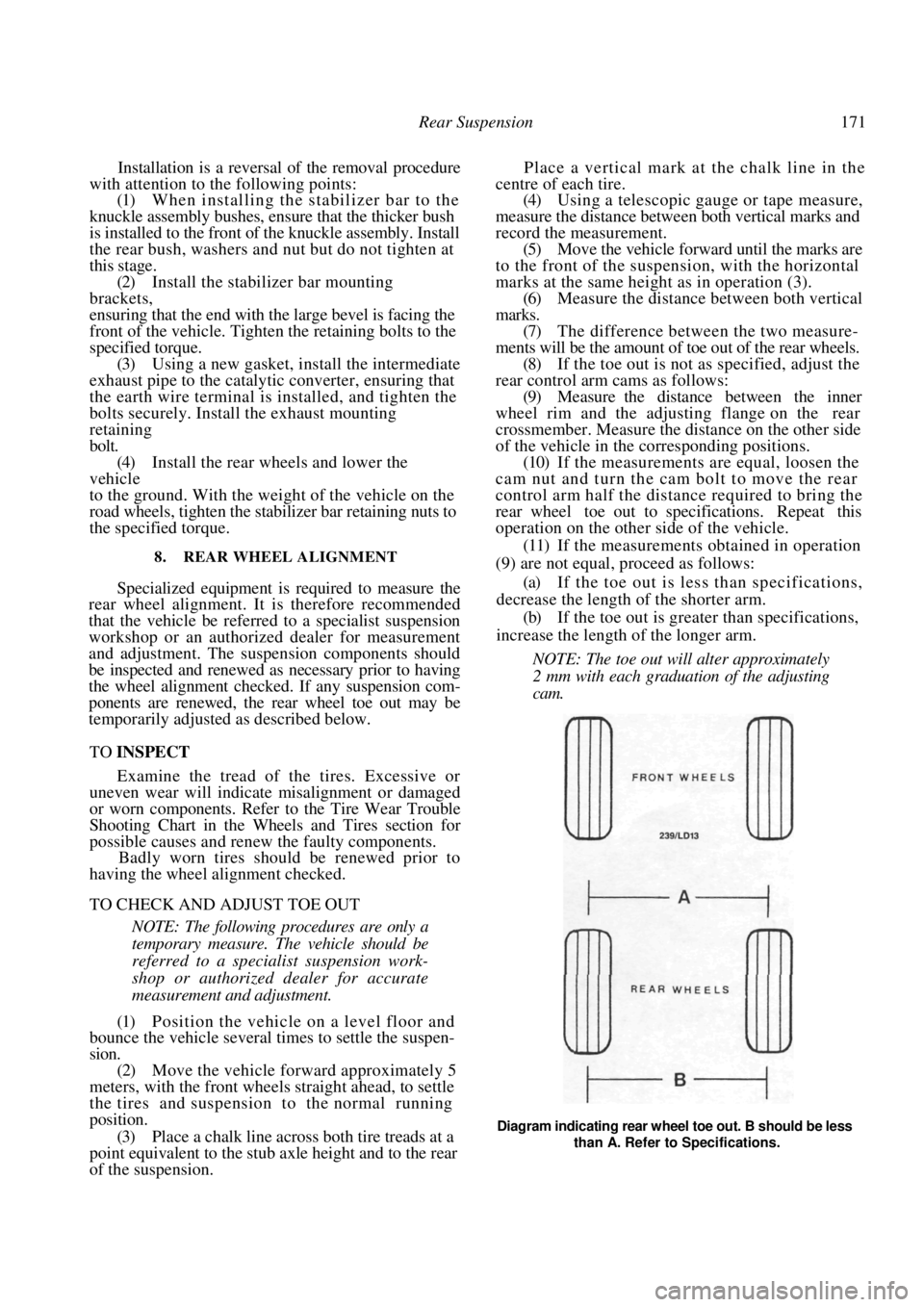
Rear Suspension 171
Installation is a reversal of the removal procedure
with attention to the following points:
(1) When installing the stabilizer bar to the
knuckle assembly bushes, ensu re that the thicker bush
is installed to the front of the knuckle assembly. Install
the rear bush, washers and nut but do not tighten at
this stage. (2) Install the stabil izer bar mounting
brackets,
ensuring that the end with the large bevel is facing the
front of the vehicle. Tighte n the retaining bolts to the
specified torque. (3) Using a new gasket, install the intermediate
exhaust pipe to the catalytic converter, ensuring that
the earth wire terminal is installed, and tighten the
bolts securely. Install the exhaust mounting
retaining
bolt. (4) Install the rear wheels and lower the
vehicle
to the ground. With the wei ght of the vehicle on the
road wheels, tighten the stabilizer bar retaining nuts to
the specified torque.
8. REAR WHEEL ALIGNMENT
Specialized equipment is required to measure the
rear wheel alignment. It is therefore recommended
that the vehicle be referred to a specialist suspension
workshop or an authorized dealer for measurement
and adjustment. The suspension components should
be inspected and renewed as necessary prior to having
the wheel alignment checked. If any suspension com-
ponents are renewed, the re ar wheel toe out may be
temporarily adjusted as described below.
TO INSPECT
Examine the tread of the tires. Excessive or
uneven wear will indicate misalignment or damaged
or worn components. Refer to the Tire Wear Trouble
Shooting Chart in the Wheels and Tires section for
possible causes and renew the faulty components.
Badly worn tires should be renewed prior to
having the wheel alignment checked.
TO CHECK AND ADJUST TOE OUT
NOTE: The following procedures are only a
temporary measure. Th e vehicle should be
referred to a specialis t suspension work-
shop or authorized dealer for accurate
measurement and adjustment.
(1) Position the vehicle on a level floor and
bounce the vehicle several tim es to settle the suspen-
sion. (2) Move the vehicle forward approximately 5
meters, with the front wheels straight ahead, to settle
the tires and suspension to the normal running
position.
(3) Place a chalk line across both tire treads at a
point equivalent to the stub axle height and to the rear
of the suspension. Place a vertical mark at the chalk line in the
centre of each tire.
(4) Using a telescopic gauge or tape measure,
measure the distance between both vertical marks and
record the measurement. (5) Move the vehicle forward until the marks are
to the front of the suspen sion, with the horizontal
marks at the same height as in operation (3). (6) Measure the distance between both vertical
marks. (7) The difference between the two measure-
ments will be the amount of toe out of the rear wheels. (8) If the toe out is not as specified, adjust the
rear control arm cams as follows: (9) Measure the distance between the inner
wheel rim and the adjusting flange on the rear
crossmember. Measure the distance on the other side
of the vehicle in the corresponding positions. (10) If the measurements are equal, loosen the
cam nut and turn the cam bolt to move the rear
control arm half the distance required to bring the
rear wheel toe out to specifications. Repeat this
operation on the other side of the vehicle.
(11) If the measurements obtained in operation
(9) are not equal, proceed as follows:
(a) If the toe out is less than specifications,
decrease the length of the shorter arm.
(b) If the toe out is greater than specifications,
increase the length of the longer arm.
NOTE: The toe out will alter approximately
2 mm with each graduation of the adjusting
cam.
Diagram indicating rear wheel toe out. B should be less than A. Refer to Specifications.
Page 182 of 238
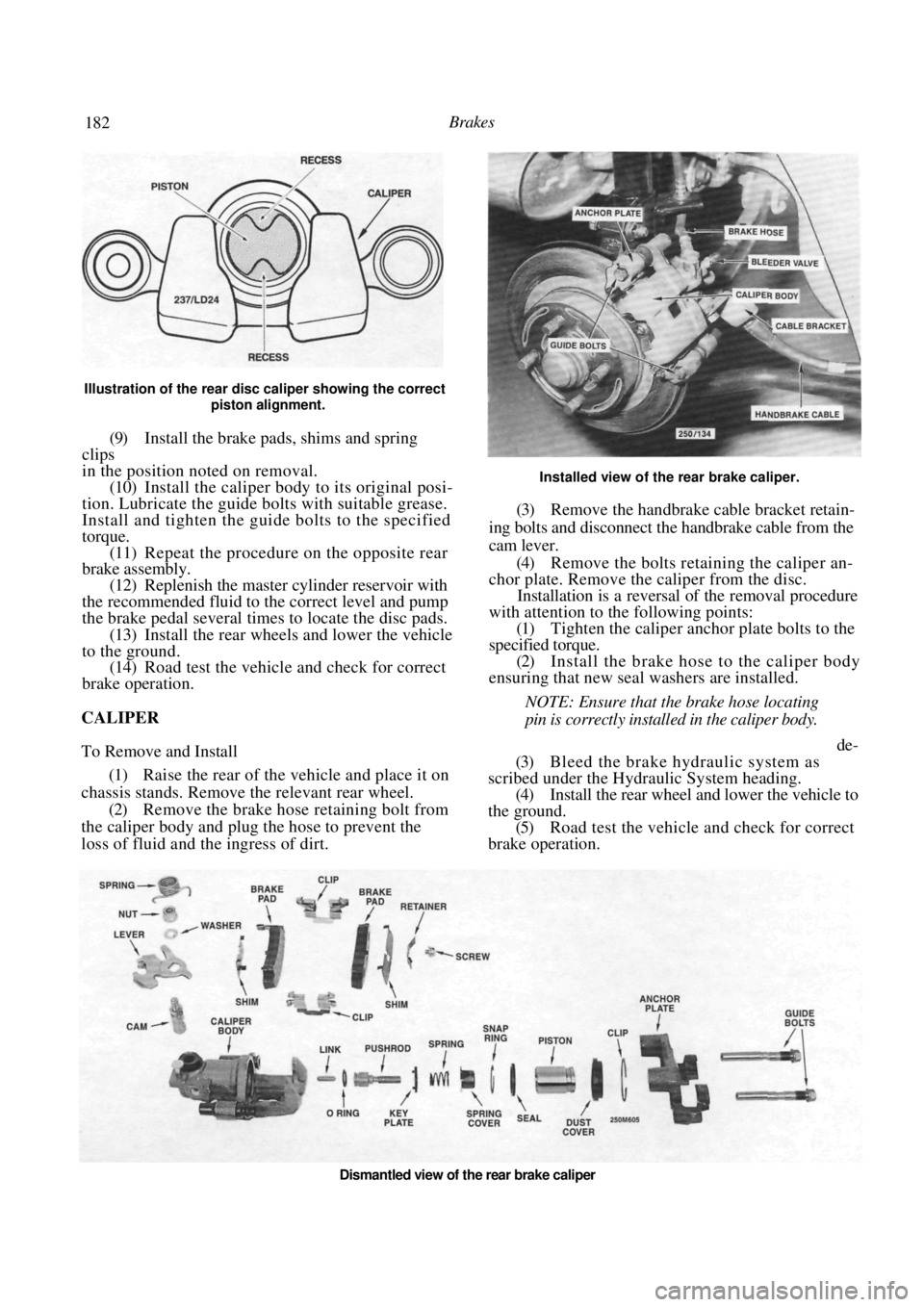
182 Brakes
Illustration of the rear disc caliper showing the correct
piston alignment.
(9) Install the brake pads, shims and spring
clips
in the position noted on removal. (10) Install the caliper body to its original posi-
tion. Lubricate the guide bolts with suitable grease.
Install and tighten the guide bolts to the specified
torque. (11) Repeat the procedure on the opposite rear
brake assembly.
(12) Replenish the master cylinder reservoir with
the recommended fluid to the correct level and pump
the brake pedal several times to locate the disc pads. (13) Install the rear wheels and lower the vehicle
to the ground. (14) Road test the vehicle and check for correct
brake operation.
CALIPER
To Remove and Install
(1) Raise the rear of the vehicle and place it on
chassis stands. Remove the relevant rear wheel. (2) Remove the brake hose retaining bolt from
the caliper body and plug the hose to prevent the
loss of fluid and the ingress of dirt.
Installed view of the rear brake caliper.
(3) Remove the handbrake cable bracket retain-
ing bolts and disconnect the handbrake cable from the
cam lever. (4) Remove the bolts retaining the caliper an-
chor plate. Remove the caliper from the disc. Installation is a reversal of the removal procedure
with attention to the following points:
(1) Tighten the caliper anch or plate bolts to the
specified torque. (2) Install the brake hose to the caliper body
ensuring that new seal washers are installed.
NOTE: Ensure that the brake hose locating
pin is correctly installed in the caliper body.
de-
(3) Bleed the brake hydraulic system as
scribed under the Hydraulic System heading. (4) Install the rear wheel and lower the vehicle to
the ground. (5) Road test the vehicle and check for correct
brake operation.
Dismantled view of the rear brake caliper